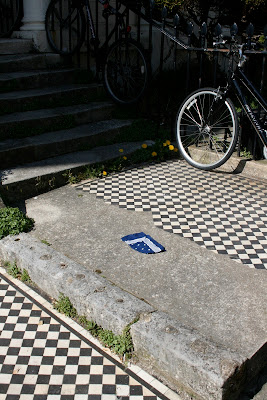Oddments: "An item or
piece left over from a larger piece or set."(Oxford Dictionary)
The idea of the
left or ‘oddmented’ item is pivotal to the works that appear in this book. The images
selected to form this book are taken form the ongoing body of work that is
'Oddments’. It signifies a chapter in the current work that has been formulated
over a period of three years. The majority of the images that appear in the book
were taken in a small network of streets in the area of my hometown of Brighton
and Hove. The street and the
trace residues of people’s interaction upon the city have been my inspiration
for the project. Adopting a documentary like approach I repeatedly visited the
same streets for a period of three years.
Seeking out the
uninformed or discarded items became an obsession, and I would liken my
approach to that of a hunter seeking out its prey. Often my walk would be
unfruitful and I would return home with few or no images of note; again and
again though I would venture out, sometimes coming across a bounty of oddments
with which to feast my camera upon. Often my mood would dictate what it was
that I would be drawn to photograph, the eclectic set of images is perhaps a
reflection, in part, of my varying shades of character at the time of exposure.
My interest in the
isolation and disconnection of items from their source stems from a longing for
signs and randomness, a welcome break from the all too often sterile monotony
of the clinical and regimented landscapes we can inhabit. Living all my life
in Brighton and Hove I have looked on in interest at these oddments; in a city
populated largely by students and artists it is a cityscape constantly in a
state of flux from their expression in the streets.
The ‘out of sorts’
existence of these statements, or just discarded items exist for often only the
shortest of times in a street, which is constantly in a state of perpetual
transience and maintenance. This here-today and gone-tomorrow appearance of
objects which have often evoked laughter or sparked interest have saddened me when
the next day they have been removed as they are not part of the streets’
original functionality.The attempt to rid
this middle ground of the residue of discarded fragments of ‘others’ is a
battle between expression, interaction, communication, self-expression and the
'state'. And it seemed to me now that perhaps my work is a reflection of a need
to preserve these moments of inspiration and enjoyment for both myself, and
others in photographic form.
When I refer to
the word state here it can be sub divided to refer to two themes which, I feel,
are applicable to the understanding of the creation and life of these oddments.
The first is, the streets state its purpose and functionality, and the overall
consensuses of ideas of the street’s function as a communal regimented
landscape. The second directly refers to the governmental often-oppressive
state.
Note though that this project is not primarily politically loaded body
of work which sets out to label the government as an artistically oppressive
group, but to not mention the presence of the government upon street art would
none the less be naive in any discussion on community art and control. Having established
some of the themes of the works and their origins I now want to bring the
introduction of the work back to the idea of signs. The artist Oliver
Ritchen once stated in relation to his book of images Real Allegories, "that…to make the object photographed itself
an image, a sign for something else."
This idea of the
thing itself being a sign for something else has inspired many of my images; a
photograph itself is an object in itself, a vessel, a sign for something else.
The items or signs, which I am drawn to seem to represent to me a sign or
signifier for something else also, the idea of prediction and symbolism are
themes that I have explored in often comical and self-referential ways. The
juxtapositions in frame and in the placement within this book help to bring
together the eclectic themes of the work.
In creating this work I hope to both entertain and inspire, and to draw attention to the all to often
overlooked everyday oddments.
I hope to evoke
open thought about what could be seen as haphazardly discarded items and to
pace them into a context whereby they create meaning and motive for another
vessel or train of thought.
The varying
interpretation of these photographs is encouraged, the items and signs in our
everyday walks of life are all too easily forgotten or washed away; by
photographing them I hope to encapsulate them and thereby encourage thought and
emotions inspired by the left objects of other.
Ella
Penn.
 |
| One man and his dog |
|
|
|
|
 |
Spilt Milk |
 |
| Barbie |
For details of where to purchase a copy of this book please visit:
www.blurb.es/b/1885477-oddments-ella-penn






No comments:
Post a Comment